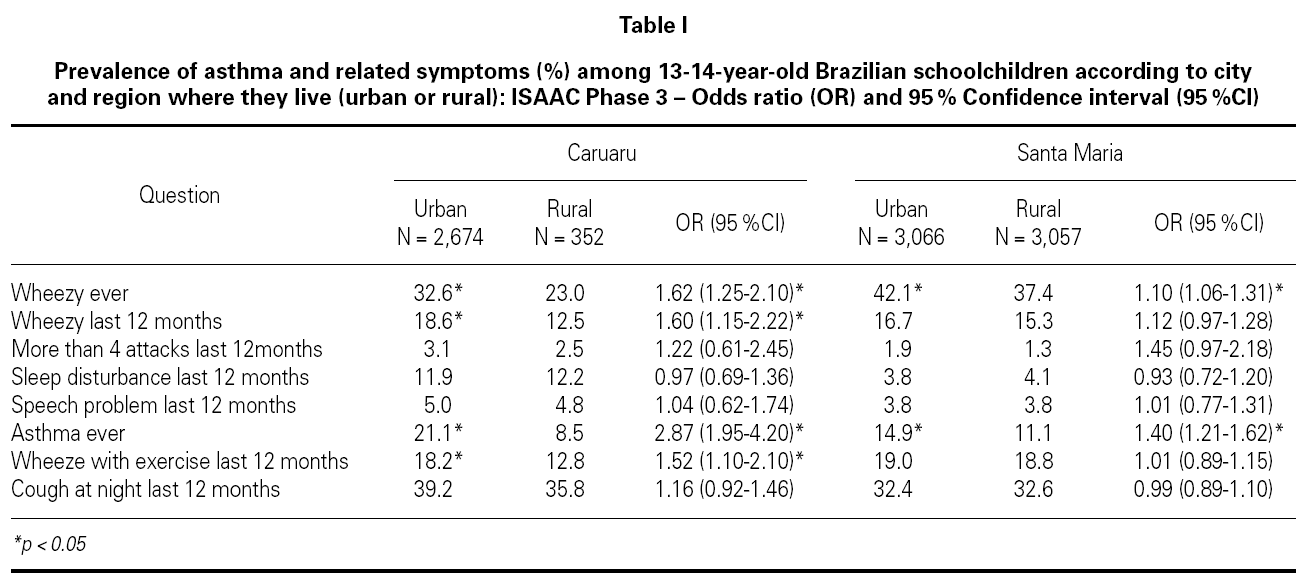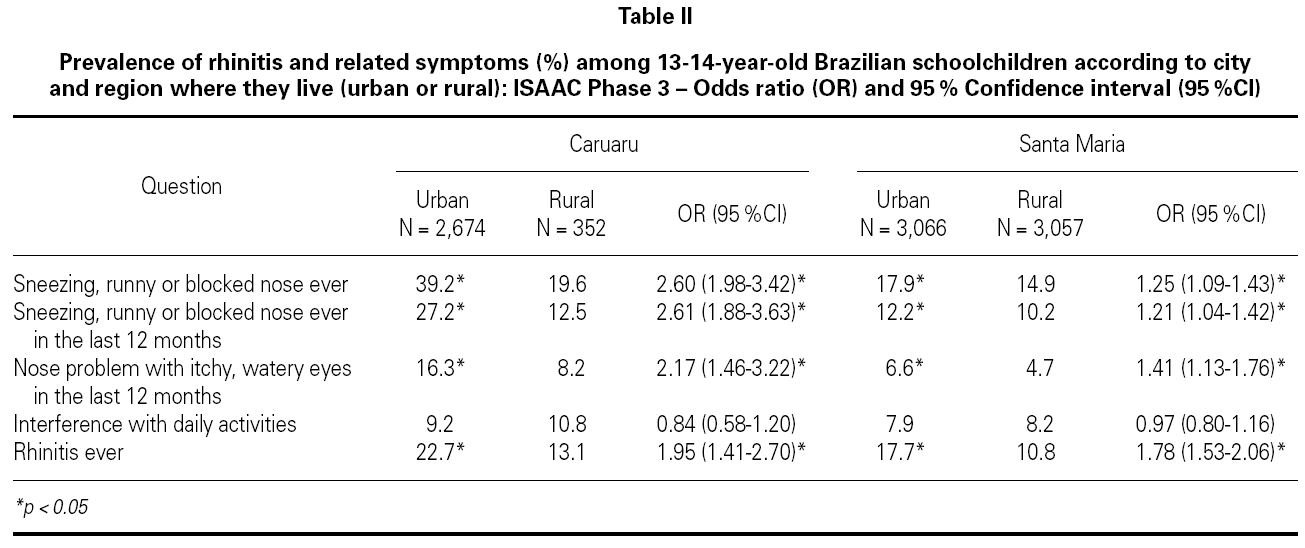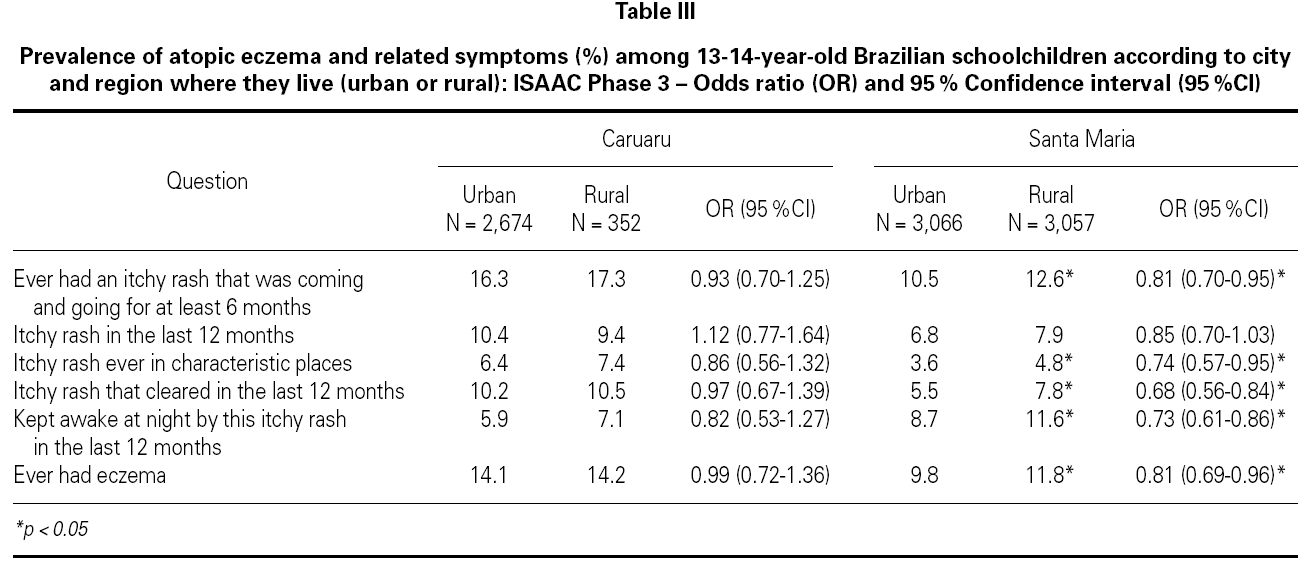INTRODUCTION
Charles Blackley, more than 100 years ago, was the first to notice that hay fever was remarkably rare in farming families1. Since then an increasing prevalence of allergic diseases has been reported, and in a simple way, has been related to urbanization and western lifestyle2-11.
Some of the factors being investigated as protective against the onset of asthma and allergic diseases include early exposure to infectious agents and/or endotoxins6,12, to be born and growing up in a rural area1,13, to live in an environment with great number of children6,12, to have received low amounts of antibiotics, to have been long-term breast fed12, and to have received a special diet (fresh fruits and vegetables, long-chain polyunsaturated fatty acids, and vitamin A) during the first year of life12.
Growing up in farms, mainly in those engaged in cattle breeding, poultry or animal production has been linked to a lower prevalence of atopic sensitization and hay fever. However, epidemiological studies have shown conflicting evidences about the lower risk of atopic diseases in children living in rural areas compared to those living in urban areas14-18.
Remes et al, evaluating adolescents, demonstrated a reduced risk of questionnaire-reported hay fever in children living in farms with livestock19. In another study, also in Finland, Kilpelainen et al observed a slightly reduced risk of asthma among farmer's children20. When we interpret the results of these trials it is necessary to known that farms around the world certainly do not have the same scale and kind of operation. This would be responsible in part for the discrepancy observed among these studies. Downs et al, keeping this doubt in mind, have studied the prevalence of allergic diseases in two Australian rural towns with different farming activities: mixed and crop. They have observed a lower risk of atopy among those children that were born and lived at least 1 year in farms with mixed activity (livestock and crop)21.
In Brazil, studies evaluating the prevalence of asthma and allergic diseases among children living in rural area compared to urban area are rare. Maia et al evaluated the prevalence of asthma and related symptoms among adolescents living in Montes Claros, a small city in the countryside of the state of Minas Gerais, Southeastern of Brazil. They identified as risk factors for higher prevalence of current wheezing to have a family history of asthma, to have contact with pets, and being student in an urban school22.
The International Study of Asthma and Allergies in Childhood (ISAAC) phase 3 has shown higher prevalence of wheezing, nasal symptoms and cutaneous rash in the last 12 months in centers from Northern (N) and Northeastern (NE) regions of Brazil23. As Brazil was colonized by Portuguese, invaded by several other nations and received in the last century millions of immigrants, Brazilian people hasn't a characteristic genetic pattern. This is one of the main difficulties for comparison between different centers from different regions of the country.
The aim of this study was to evaluate if adolescents with similar genetic background, living in a rural area are protected against the development of symptoms of asthma, rhinitis, and atopic eczema when compared to those living in an urban area in the same region of the country.
SUBJECTS AND METHODS:
Adolescents (13-14 year-old) living in Caruaru (state of Pernambuco) and in Santa Maria (state of Rio Grande do Sul) were enrolled in this study (2002-2003). They were selected as standardized by ISAAC protocol24,25 among those who had attended public and private schools localized in these cities. Information regarding the number of schools and students in each city was obtained from their respective City Education Secretaries official records. According to the place were they lived, adolescents were divided in two groups: urban (U) and rural (R).
Caruaru and Santa Maria are small countryside cities with different climate and socioeconomic status. Caruaru is in the NE region of Brazil, has 253,634 inhabitants (85.6 % urban) living in a total area of 928.08 Km2. Its latitude is 8° 179 00ç S, its longitude is 35° 589 34ç W. Gr, and its altitude is 555m. Climate is hot semi-arid with a mean annual temperature of 24 °C26. Santa Maria is in the S region, has 243,396 inhabitants (84.7 % urban) living in a total area of 1,823.1 Km2. Its latitude is 29° 689 17ç S, its longitude is 53° 809 69ç W. Gr, and its altitude is 113 m. The climate in Santa Maria is subtropical, seasons are better defined, and the mean annual temperature is 19.2 °C27.
According to the Brazilian Institute of Geography and Statistics (IBGE) an urban area was defined as those corresponding to towns (municipal headquarters), villages (county headquarters) or isolated urban areas, and a rural area was defined as all area out of the limits of an urban area28.
Considerations about socioeconomic status were based on the state infant mortality index (number of dead children younger than 1 year old per 1,000 live births) and on the city Gross Domestic Product (GDP). During 2003, the infant mortality index in Pernambuco was 60.46 and the Caruaru's GDP was R$1,042,163 26. The infant mortality in the state of Rio Grande do Sul was 18.99 and Santa Maria's GDP was R$1,554, 394 26 (US$1.00 = 3.00 Brazilian Reais [R] in 2003).
The percentage of population in the age period of 13 to 14 years in the states of Rio Grande do Sul and Pernambuco was 4.0 % and 4.2 % of the total population living in Southern and Northern regions, respectively29. Expecting to have at a difference of at least 6 % in the prevalence of current asthma (wheezy in the last 12 months) between adolescents living in rural and urban areas [mean prevalence of current asthma = 20 % (ISAAC fase 1)], with a test power of 80 %, and alpha risk of 5 %, the total number of evaluated adolescents would be 551.
In Caruaru the selection of adolescents was based on the distribution of the whole population: rural (14 %) and urban (86 %) inhabitants26. Of the 3,026 adolescents enrolled, 2,674 (88.3 %) and 352 (11.7 %) were U and R, respectively. In Santa Maria participated 3,066 U adolescents and 3,057 R adolescents from 10 small cities in the neighborhood of Santa Maria.
After sample definition, the adolescents filled in the ISAAC written questionnaire (WQ), previously translated and validated to the Brazilian culture30-32. The WQ was fulfilled in the classroom under the supervision of the researcher. Data obtained were transcribed manually into a database (Epi-Info) supplied by ISAAC's coordinators and were statistically analyzed by the SSPS-12 software. The frequency of affirmative answers to each question was considered according to the city evaluated. The comparison between U and R, in each city, were analyzed by the Chi-square test and the results were expressed as Odds ratio (OR) with 95 % confidence intervals (95 %CI)33. The level of rejection of null hypothesis was 5 %. The study was approved by the Ethical Committee of Federal University of Pernambuco and Federal University of Santa Maria. A sign informed consent was obtained by all adolescents' parents.
RESULTS
In general the prevalence of asthma related symptoms were higher among those adolescents living in the urban centers in comparison to the rural ones (table I). These differences were significant for wheezy ever, wheezy in the last 12 months, asthma ever, and wheezy with exercise in Caruaru and for wheezy ever and asthma ever, in Santa Maria. Comparing urban areas, the prevalence of asthma related symptoms in Caruaru was higher than in Santa Maria, except for wheezy ever and wheezy with exercise. The opposite was observed comparing rural areas: the prevalence of asthma (except for nocturnal cough) was higher in Santa Maria despite lesser severity of symptoms in this city.
Except for the prevalence of nasal symptoms interfering with daily activities, all rhinitis related symptoms were significantly higher among adolescents living in urban area, in both cities (table II). As observed with asthma symptoms, the prevalence of rhinitis related symptoms was higher among U Caruraru adolescents in comparison to U Santa Maria adolescents. In the other hand, and contrary to that observed with asthma, the prevalence of rhinitis and its symptoms was higher among R Caruaru adolescents in comparison to R Santa Maria adolescents.
Table III Prevalence of atopic eczema and related symptoms (%) among 13-14-year-old Brazilian schoolchildren according to city and region where they live (urban or rural): ISAAC Phase 3 Odds ratio (OR) and 95 % Confidence interval (95 %CI)
DISCUSSION
Brazil is a continental country, whose total area of 8,5 million square kilometers is cut in N by the Equator line and in SE by the Tropic of Capricorn. Secondary to its colonization, a period of slavery (mainly in NE and SE regions) and immigration in the last century (mainly to S and SE regions), Brazilian population has a high degree of miscegenation that explains the high Brazilian people heterogeneity characterizing us as a genetic cauldron. So, genetic studies or comparisons between Brazilian people living in different parts of the country are difficult. Trying to minimize bias we decided to study people living in rural and urban areas in the same neighborhood, in different regions of Brazil.
Sometimes, even studying people living in the same area, it is important to know that they have apparently the same genetic background. In a recent study, Soares et al have evaluated the prevalence of asthma and related symptoms applying ISAAC WQ among Indians living in a village near of the city of Maceió the capital of Alagoas state (NE region of Brazil).
These individuals live in conditions very similar of those their ancestors used to live, in extreme poverty, low level of sanitation without potable water and sewer, high level of illiteracy, high frequency of helmintiasis and a mean income lower than US$5034.
In comparison to children living in Maceió, the prevalence of current asthma was lower, for both age periods evaluated: six times among children aged 6-7 years (4 % x 24 %) and less among adolescents aged 13-14 years (10.0 % x 14.7 %)23,35.
The first impression we have when analyzing these data is that the Hygiene Hypothesis could be played a role in the results of prevalence of asthma among these Indian children population.
However, it is important to point out that children living in the city of Maceió and these Indians are genetically different once the level of miscegenation among Indians almost does not exist34. So we could not make any speculation about the role of Hygiene Hypothesis in the data observed. Because of this we decided to study population been apparently of the same genetic background, living in different places in the same region of the country.
Although in this study, the prevalence of helmintiasis was not appraised, Nascimento Silva did not observe any difference in the prevalence of asthma between low socio-economic children with or without ascariasis, living in Campina Grande, a city located near to Caruaru36.
An inverse relationship between mean annual outdoor temperature and humidity and the prevalence of asthma, allergic rhinoconjunctivitis, and atopic eczema among children from 146 ISAAC's phase I participant centers was documented: high temperature and humidity were associated to lower prevalence37. In this study we observed the opposite.
Despite climate and cultural differences between people living in the NE and S of Brazil, the rural way of life in both are quite similar. In general, farm's houses in Brazil are different from those in Europe5,13,14. While small animals (dog, duck, hen) circulate freely among human beings, the big ones (e.g cows, horses) are maintained in stables, frequently far away from the house. In these areas consuming unpasteurized milk is frequent.
It has been reported that reduction of allergic diseases among children who were born and raised in a farm environment, in comparison to those living in urban area, is due to their exposure to poultry and livestock38-40. Until recently, exposure to high levels of endotoxin was associated with exposure to farm animals, presence of pets in home, number of people living in the house and cleaning habits41. However, results of a study carried out on children from rural areas in Europe, evaluating farm-related exposures and health outcomes, revealed that levels of endotoxin and extracellular polysaccharides were associated to health outcomes independently of the farm exposures42. In a birth cohort study the increased endotoxin exposure was associated with a reduced risk of allergic sensitization and eczema, and with an increased risk of non-atopic wheeze, only in children with the CC genotype at 159 of the CD14 gene43.
In India, Vedanthan et al have evaluated possible factors related to development of asthma and allergic diseases among children from two different communities: urban and rural. They observed that those children who live with close animal contact and mud flooring and who were exclusively breastfed (at least 6 months) in infancy are less likely to develop asthma, rhinitis, and atopic sensitization38.
In general, we observed a tendency for higher values of prevalence of asthma and rhinitis but not eczema related symptoms among those adolescents living in urban area, as in Caruaru as in Santa Maria. Our data confirms that living in a rural area is associated to a decrease in the prevalence of symptoms related to asthma and allergic rhinitis among Brazilian children from two different regions of the country.
Correspondence:
Dirceu Solé
Rua Mirassol 236, apto 72
04044-010, Vila Mariana,
Sã Paulo, SP. Brazil
Phone/fax: + 55 11 5579 1590
E-mail: dirceusole.dped@epm.br










